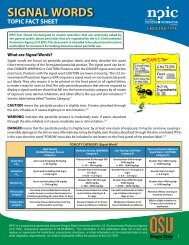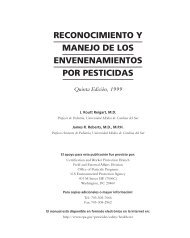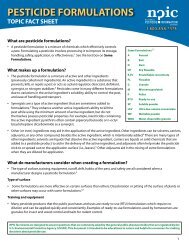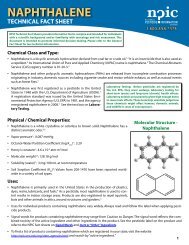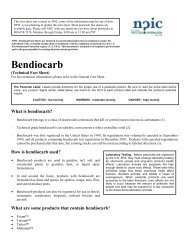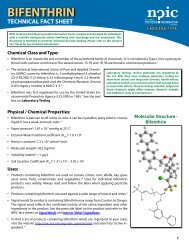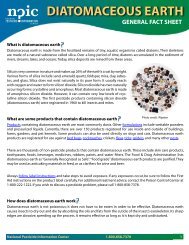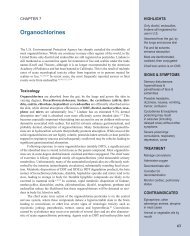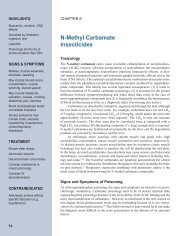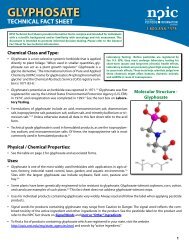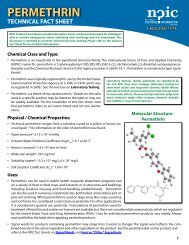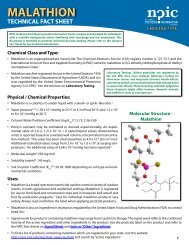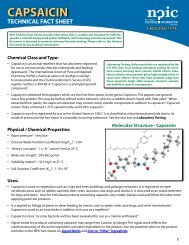Paraquat and Diquat - National Pesticide Information Center
Paraquat and Diquat - National Pesticide Information Center
Paraquat and Diquat - National Pesticide Information Center
You also want an ePaper? Increase the reach of your titles
YUMPU automatically turns print PDFs into web optimized ePapers that Google loves.
<strong>Paraquat</strong> & <strong>Diquat</strong><br />
HIGHLIGHTS<br />
Toxic doses are life<br />
threatening<br />
Impacts GI tract, kidney,<br />
lungs, liver, heart, other<br />
organs<br />
Pulmonary rosis is the<br />
usual cause of death in<br />
paraquat poisoning<br />
<strong>Diquat</strong> has greater renal<br />
activity<br />
Can be measured in<br />
blood <strong>and</strong> urine by<br />
spectrophotometric, gas<br />
chromatographic, liquid<br />
chromatographic <strong>and</strong><br />
radioimmunoassay<br />
SIGNS & SYMPTOMS<br />
Ingestion (either): burning<br />
pain in mouth, throat, chest,<br />
upper abdomen; pulmonary<br />
edema, pancreatitis, renal &<br />
CNS effects<br />
Dermal (paraquat): dry <strong>and</strong><br />
ssured h<strong>and</strong>s, horiontal<br />
ridging or loss of ngernails,<br />
ulceration, abrasion<br />
<strong>Diquat</strong>: CNS toxicity as<br />
nervousness, irritability,<br />
combativeness,<br />
disorientation, diminished<br />
reexes<br />
CHAPTER 12<br />
<strong>Paraquat</strong> <strong>and</strong> <strong>Diquat</strong><br />
<br />
<strong>Paraquat</strong> is a synthetic, non-selective contact herbicide, marketed as paraquat,<br />
paraquat dichloride salt <strong>and</strong> bismethylsulfate salt. Liquid technical products range<br />
from to concentration, but the formulations used in the eld range from<br />
0.07% to 0.14%. It is a restricted use pesticide.<br />
<strong>Diquat</strong> is usually prepared as the dibromide monohydrate salt, 15%-25% in<br />
liquid concentrates, but the formulations in the eld are usually 0.2%. <strong>Diquat</strong> dibromide<br />
is a non-selective contact herbicide, desiccant <strong>and</strong> plant growth regulator for use<br />
as a general herbicide for control of broadleaf <strong>and</strong> grassy weeds in terrestrial non-crop<br />
<strong>and</strong> aquatic areas; as a desiccant in seed crops <strong>and</strong> potatoes; <strong>and</strong> for tassel control <strong>and</strong><br />
spot weed control in sugarcane. Unlike paraquat, it is not registered as a restricted use<br />
pesticide.<br />
PARAQUAT<br />
Toxicology<br />
When a toxic dose is ingested (see below), paraquat has life-threatening effects on<br />
the gastrointestinal tract, kidney, liver, heart <strong>and</strong> other organs. The LD 50<br />
in humans<br />
is approximately 3-5 mg/kg, which translates into as little as 10-15 mL of a 20%<br />
solution. 1,2 In spite of the fact that the lung is the primary target organ, toxicity from<br />
inhalation is rare.<br />
Although pulmonary toxicity occurs later in paraquat poisoning than other<br />
manifestations, it is the most severe <strong>and</strong>, therefore, mentioned rst. Pulmonary effects<br />
represent the most lethal <strong>and</strong> least treatable manifestation of toxicity from this agent.<br />
The primary mechanism is through the generation of free radicals with oxidative<br />
damage to lung tissue. 1,2 While acute pulmonary edema <strong>and</strong> early lung damage may<br />
occur within a few hours of severe acute exposures, 3,4 the delayed toxic damage of<br />
pulmonary brosis, the usual cause of death, most commonly occurs 7-14 days after<br />
the ingestion. 5 In those patients who ingest a very large amount of concentrated solution<br />
(20%), some have died more rapidly from circulatory failure (within 48 hours)<br />
prior to the onset of pulmonary brosis. 5<br />
Both types I <strong>and</strong> II pneumatocytes appear to selectively accumulate paraquat.<br />
Biotransformation of the paraquat in these cells results in free-radical production with<br />
resulting lipid peroxidation <strong>and</strong> cell injury. 1,2,3 emorrhagic proteinaceous edema uid<br />
<strong>and</strong> leukocytes inltrate the alveolar spaces, after which there is rapid proliferation of<br />
broblasts. There is a progressive decline in arterial oxygen tension <strong>and</strong> 2<br />
diffusion<br />
capacity. Such a severe impairment of gas exchange causes progressive proliferation<br />
of brous connective tissue in the alveoli <strong>and</strong> eventual death from asphyxia <strong>and</strong> tissue<br />
anoxia. 6 ne study of survivors suggests that some of the brous toxic damage may<br />
be reversible, as evidenced by markedly improved pulmonary function tests 3 months<br />
after survival. 7<br />
110
Local skin damage includes a contact dermatitis. Prolonged contact will produce<br />
erythema, blistering, abrasion, ulceration <strong>and</strong> ngernail changes. 8,9 Although absorption<br />
across intact skin is slow, abraded or eroded skin allows efcient absorption.<br />
The gastrointestinal (GI) tract is the site of initial or Phase 1 toxicity to the<br />
mucosal surfaces following ingestion of the substance. This toxicity is manifested by<br />
swelling, edema <strong>and</strong> painful ulceration of the mouth, pharynx, esophagus, stomach<br />
<strong>and</strong> intestine. With higher levels, other GI toxicity includes centrizonal hepatocellular<br />
injury that can cause elevated bilirubin, <strong>and</strong> hepatocellular enzymes such as AST, ALT,<br />
LDH <strong>and</strong> alkaline phosphatase.<br />
Damage to the proximal renal tubule occurs <strong>and</strong> is often more reversible than<br />
the destruction to lung tissue. However, impaired renal function may play a critical<br />
role in determining the outcome of paraquat poisoning. Normal tubule cells actively<br />
secrete paraquat into the urine, efciently clearing it from the blood; but high blood<br />
concentrations poison the secretory mechanism <strong>and</strong> may destroy the cells. <strong>Diquat</strong><br />
poisoning typically results in greater renal injury than paraquat. 10<br />
Focal necrosis of the myocardium <strong>and</strong> skeletal muscle are the main features of<br />
toxicity to any type of muscle tissue <strong>and</strong> typically occurs following the Phase 1 gastrointestinal<br />
toxicity.<br />
Ingestion has been reported to cause cerebral edema <strong>and</strong> brain damage. At<br />
necropsy, brain damage was found in the form of moderate neuronal depletion, probably<br />
secondary to anoxia, <strong>and</strong> damage to the central white matter <strong>and</strong> particularly<br />
the brain around the lateral <strong>and</strong> third ventricles. Examination of the brain by electron<br />
microscopy showed edema <strong>and</strong> destruction of myelin, with abundant myelin breakdown<br />
products, <strong>and</strong> astrocytic brous gliosis. 11<br />
Although much concern has been expressed about effects of smoking paraquatcontaminated<br />
marijuana, toxic effects by this mechanism have been either very rare<br />
or nonexistent. Most paraquat that contaminates marijuana is pyrolyzed to dipyridyl<br />
during smoking, which is a product of leaf (including marijuana) combustion <strong>and</strong><br />
presents little toxic hazard.<br />
CHAPTER 12<br />
<strong>Paraquat</strong> & <strong>Diquat</strong><br />
<strong>Paraquat</strong> & <strong>Diquat</strong><br />
TREATMENT<br />
Immediate GI<br />
decontamination with<br />
Bentonite, Fuller’s Earth or<br />
activated charcoal<br />
Maintain urinary output by<br />
administering IV, but monitor<br />
uids in case of renal failure<br />
Decontaminate eyes <strong>and</strong><br />
skin<br />
CONTRAINDICATED<br />
Supplemental oxygen<br />
(unless patient develops<br />
hypoxemia)<br />
Signs <strong>and</strong> Symptoms of Poisoning<br />
Initial clinical signs depend upon the route of exposure. Early symptoms <strong>and</strong> signs<br />
of poisoning by ingested paraquat are burning pain in the mouth, throat, chest <strong>and</strong><br />
upper abdomen, due to the corrosive effect of paraquat on the mucosal lining. Diarrhea,<br />
which is sometimes bloody, can also occur. Giddiness, headache, fever, lethargy<br />
<strong>and</strong> coma are other examples of NS <strong>and</strong> systemic ndings. Pancreatitis may<br />
cause severe abdominal pain. Proteinuria, hematuria, pyuria <strong>and</strong> azotemia reect renal<br />
injury. Oliguria/anuria indicates acute tubular necrosis. Because the kidneys are almost<br />
the exclusive route of paraquat elimination from body tissues, renal failure fosters a<br />
buildup of tissue concentration, including the very important concentration in the lung.<br />
Unfortunately, this pathogenic sequence may occur in the rst several hours<br />
following paraquat ingestion, generating lethal concentrations of paraquat in lung<br />
tissue before therapeutic measures to limit absorption <strong>and</strong> enhance disposition have<br />
taken effect. It is probably for this reason that methods for enhancing paraquat disposition<br />
several hours following ingestion have had little effect on mortality. 9<br />
Cough, dyspnea <strong>and</strong> tachypnea usually appear 2-4 days following paraquat<br />
ingestion but may be delayed as long as 14 days. Progressive cyanosis <strong>and</strong> dyspnea<br />
reect deteriorating gas exchange in the damaged lung. In some cases, the coughing<br />
up of frothy sputum (pulmonary edema) is the early <strong>and</strong> principal manifestation of<br />
paraquat lung injury. 9<br />
Dermal signs are common among agriculture workers with acute skin exposure<br />
to paraquat. Particularly in concentrated form, paraquat causes localized injury<br />
111
CHAPTER 12<br />
<strong>Paraquat</strong> & <strong>Diquat</strong><br />
<strong>Paraquat</strong><br />
COMMERCIAL<br />
PRODUCTS<br />
Bonre<br />
Firestorm<br />
Gramoxone<br />
Helmquat<br />
Para-Shot<br />
Parazone<br />
Quik-Quat<br />
<strong>Diquat</strong><br />
COMMERCIAL<br />
PRODUCTS<br />
Chemsico<br />
Rapid Kill<br />
Razor Burn<br />
Reglone<br />
Touchdown<br />
Weedtrine-D<br />
to tissues with which it comes into contact. Fatal poisonings are reported to have<br />
occurred as a result of protracted dermal contamination by paraquat, but this is likely<br />
to occur only when the skin’s barrier integrity is impaired due to abrasion, erosion<br />
or other pathologic processes. In these cases, more efcient systemic absorption can<br />
occur. With an intact dermal barrier, paraquat leaves the skin of the h<strong>and</strong>s dry <strong>and</strong><br />
ssured, <strong>and</strong> causes horizontal ridging of the ngernails. Chronic exposure may even<br />
result in the loss of ngernails. Prolonged contact with skin will create ulceration <strong>and</strong><br />
abrasion sufcient to allow systemic absorption. 9<br />
In addition, some agriculture workers can be exposed through prolonged inhalation<br />
of spray droplets <strong>and</strong> develop nosebleeds because of local damage. However,<br />
inhalation has not resulted in systemic toxicity because of the low vapor pressure <strong>and</strong><br />
lower concentration of paraquat eld formulations.<br />
Eye contamination with paraquat concentrate or higher concentration diluted<br />
solutions results in severe conjunctivitis <strong>and</strong> sometimes protracted corneal opacication.<br />
12,13<br />
The hepatic injury from paraquat may be severe enough to cause jaundice, which<br />
signies severe injury. However, hepatotoxicity is rarely a major determinant to clinical<br />
outcome. No hepatic signs or symptoms are present other than the abnormal laboratory<br />
values mentioned under the toxicology section.<br />
Clinical experience has offered a rough dose-effect scale on which to base prognosis<br />
in cases of paraquat ingestion 9 :<br />
1. Less than 20 mg paraquat ion per kg body weight (less than 7.5 mL of 20% [w/v]<br />
paraquat concentrate). No symptoms or only gastrointestinal symptoms occur.<br />
Recovery is likely.<br />
2. Twenty to 40 mg paraquat ion per kg body weight (7.5-15.0 mL of 20% [w/v]<br />
paraquat concentrate). Pulmonary broplasia ensues. Death occurs in most cases,<br />
but may be delayed 2-3 weeks. Multiple organ damage will occur.<br />
3. More than 40 mg paraquat ion per kg body weight (more than 15.0 mL of 20%<br />
[w/v] paraquat concentrate). Multiple organ damage occurs as in Class 2 but is<br />
more rapidly progressive. The gastrointestinal effects are often characterized by<br />
marked ulceration of the oropharynx. Mortality is essentially 100% in 1-7 days.<br />
DIQUAT<br />
Toxicology<br />
<strong>Diquat</strong> poisoning is less common than paraquat poisoning, thus the human reports<br />
<strong>and</strong> animal experimental data for diquat poisoning are less extensive than for paraquat.<br />
Systemically absorbed diquat is not selectively concentrated in lung tissue, as is<br />
paraquat, <strong>and</strong> pulmonary injury by diquat is less prominent. In animal studies, diquat<br />
causes mild, reversible injury to type I pneumatocytes but does not injure the type II<br />
cells. No progressive pulmonary brosis has been noted in diquat poisoning. 14,15<br />
However, diquat has severe toxic effects on the central nervous system that are<br />
not typical of paraquat poisoning. 14,15 While laboratory experimentation has suggested<br />
that diquat is not directly neurotoxic, there have been relatively consistent pathologic<br />
brain changes noted in reported fatal cases of diquat poisoning. These consist of brain<br />
stem infarction, particularly involving the pons. 16 It is not clear whether these postmortem<br />
changes represent direct toxicity or secondary effects related to the systemic<br />
illness <strong>and</strong> therapy. (See Signs <strong>and</strong> Symptoms section below for CNS clinical effects.)<br />
112
Signs <strong>and</strong> Symptoms of Poisoning<br />
In many human diquat poisoning cases, clinical signs of neurologic toxicity tend to be<br />
the most important. These include nervousness, irritability, restlessness, diminished<br />
reexes, combativeness, disorientation, nonsensical statements <strong>and</strong> inability to recognize<br />
friends or family members. Neurologic effects may progress to coma, accompanied<br />
by tonic-clonic seizures, <strong>and</strong> result in the death of the patient. 14,15 Parkinsonism<br />
has also been reported following dermal exposure to diquat. 17<br />
Except for the CNS signs listed in the preceding paragraph, early symptoms of<br />
poisoning by ingested diquat are similar to those from paraquat, reecting diquat’s<br />
corrosive effect on tissues. They include burning pain in the mouth, throat, chest <strong>and</strong><br />
abdomen; intense nausea <strong>and</strong> vomiting; <strong>and</strong> diarrhea. If the dosage was small, these<br />
symptoms may be delayed 1-2 days. Blood may appear in the vomitus <strong>and</strong> feces. Intestinal<br />
ileus, with pooling of uid in the gut, has characterized several human poisonings<br />
by diquat. 10<br />
The kidney is the principal excretory pathway for diquat absorbed into the body.<br />
Renal damage is, therefore, an important feature of poisonings. Proteinuria, hematuria<br />
<strong>and</strong> pyuria may progress to renal failure <strong>and</strong> azotemia. Elevations of serum alkaline<br />
phosphatase, AST, ALT <strong>and</strong> LDH reect liver injury. aundice may develop.<br />
If the patient survives several hours or days, circulatory function may fail<br />
because of dehydration. Hypotension <strong>and</strong> tachycardia can occur, with shock resulting<br />
in death. Other cardiorespiratory problems may develop such as toxic cardiomyopathy<br />
or a secondary infection such as bronchopneumonia.<br />
<strong>Diquat</strong> is somewhat less damaging to the skin than paraquat, but irritant effects<br />
may appear following dermal contamination with the concentrate. There is probably<br />
signicant absorption of diquat across abraded or ulcerated skin.<br />
The great majority of poisonings by paraquat <strong>and</strong> diquat (discussed below) have<br />
been caused by ingestion with suicidal intent, particularly in Japan 16 <strong>and</strong> many developing<br />
countries. Since 1987, there has been a decline in most countries in the total<br />
numbers of suicidal deaths attributed to paraquat <strong>and</strong> diquat. Nearly all of the relatively<br />
few occupationally related poisonings have been survived, but the mortality rate<br />
among persons who have swallowed paraquat or diquat remains high. 2,5 Avoidance of<br />
this mortality will probably have to rely on preventive strategies or on stopping gastrointestinal<br />
absorption very soon after the toxicant has been ingested.<br />
Even though intestinal absorption of dipyridyls is relatively slow, lethal uptake<br />
by critical organs <strong>and</strong> tissues apparently occurs within 18 hours, possibly within 6<br />
hours, following ingestion of toxic quantities of paraquat or diquat. Dipyridyls have<br />
large volumes of distribution. Once distribution to tissues has occurred, measures<br />
to remove dipyridyls from the blood are very inefcient in reducing the total body<br />
burden.<br />
Several strategies are being tested to reduce the frequency of these occurrences.<br />
These include the addition of emetics, stenching agents, gelling substances <strong>and</strong><br />
bittering agents such as sodium denatonium.<br />
CHAPTER 12<br />
<strong>Paraquat</strong> & <strong>Diquat</strong><br />
Conrmation of Poisoning<br />
At some treatment facilities, a simple colorimetric test is used to identify paraquat <strong>and</strong><br />
diquat in the urine <strong>and</strong> give a rough indication of the magnitude of absorbed dose. To<br />
one volume of urine is added 0.5 volume of freshly prepared 1% sodium dithionite<br />
(sodium hydrosulte) in one normal sodium hydroxide (1.0 N NaOH). The color is<br />
observed after 1 minute. Development of a blue color indicates the presence of paraquat<br />
in excess of 0.5 mg per liter. Both positive <strong>and</strong> negative controls should be run to<br />
ensure that the dithionite has not undergone oxidation in storage.<br />
113
CHAPTER 12<br />
<strong>Paraquat</strong> & <strong>Diquat</strong><br />
When urine collected within 24 hours of paraquat ingestion is tested, the dithionite<br />
test appears to have some approximate prognostic value: concentrations less than<br />
1 milligram per liter (no color to light blue) generally predict survival, while concentrations<br />
in excess of 1 milligram per liter (navy blue to dark blue) often foretell a fatal<br />
outcome. Analysis of serum by a sodium dithionite test has been reported to predict<br />
outcome in paraquat exposures. In one center a positive test was associated with 100%<br />
mortality, while negative or equivocal tests resulted in a 68% survival rate. 18<br />
<strong>Diquat</strong> in urine yields a green color with the dithionite test. Although there is less<br />
experience with this test in diquat poisonings, the association of bad prognosis with<br />
intense color is probably similar.<br />
<strong>Paraquat</strong> <strong>and</strong> diquat can be measured in blood <strong>and</strong> urine by spectrophotometric,<br />
gas chromatographic, liquid chromatographic <strong>and</strong> radioimmunoassay methods. These<br />
tests are available in numerous clinical reference laboratories <strong>and</strong> sometimes by the<br />
manufacturing company. <strong>Paraquat</strong> poisonings in which plasma concentrations do not<br />
exceed 2.0, 0.6, 0.3, 0.16 <strong>and</strong> 0.1 mg per liter at 4, 6, 10, 16 <strong>and</strong> 24 hours, respectively,<br />
after ingestion are likely to survive. 19 A comparison of several methods of measuring<br />
plasma paraquat levels revealed comparable results. However, while the positive<br />
predictive value for death was quite high, the ability to predict survival was much<br />
lower. 20<br />
Lung Imaging<br />
It has been reported that high-resolution computerized tomography of the lungs may<br />
be of predictive value in acute paraquat poisoning. A calculation is made of areas of<br />
ground glass opacities (GGOs) on tomography. In one study no patient survived when<br />
the area was greater than 40% <strong>and</strong> all survived when the area was less than 20%. 21 This<br />
study may be useful in evaluating newer therapeutic approaches.<br />
Treatment of <strong>Paraquat</strong> <strong>and</strong> <strong>Diquat</strong> Toxicosis<br />
1. Flush skin immediately with copious amounts of water to decontaminate. Irrigate<br />
the eyes with clean water for a prolonged period to remove material splashed in<br />
the eyes. Eye contamination should thereafter be treated by an ophthalmologist.<br />
Mild skin reactions usually respond to simple avoidance of further contact, but the<br />
irritation may take several weeks to resolve. Severe dermatitis with inammation,<br />
cracking, secondary infection or nail injury should be treated by a dermatologist.<br />
2. If paraquat or diquat has been ingested in any amount, immediately administer an<br />
adsorbent. This is the one therapeutic measure most likely to affect the outcome of<br />
paraquat or diquat ingestion favorably. Bentonite (7.5% suspension) <strong>and</strong> Fuller’s<br />
Earth (15% suspension) are highly effective but sometimes not available.<br />
Dosage of Bentonite <strong>and</strong> Fuller’s Earth<br />
Adults <strong>and</strong> children over 12 years: 100-150 gm<br />
Children under 12 years: 2 gm/kg body weight<br />
CAUTION: Hypercalcemia <strong>and</strong> fecaliths have sometimes occurred following<br />
<br />
114
Activated charcoal is nearly as effective, <strong>and</strong> is widely available. This treatment<br />
is discussed in Chapter 3, General Principles.<br />
CHAPTER 12<br />
<strong>Paraquat</strong> & <strong>Diquat</strong><br />
3. Secure a blood sample as soon as possible for paraquat analysis <strong>and</strong> urine samples<br />
for either paraquat <strong>and</strong>/or diquat. Serial samples of urine for either agent <strong>and</strong><br />
plasma for paraquat may be followed for prognostic information.<br />
4. Do not administer supplemental oxygen until the patient develops severe hypoxemia.<br />
High concentrations of oxygen in the lung increase the injury induced by<br />
paraquat <strong>and</strong> possibly by diquat as well. There may be some advantage in placing<br />
the patient in a moderately hypoxic environment, i.e., 15%-16% oxygen, although<br />
the benet of this treatment has not been established empirically in human poisonings.<br />
Inhalation of nitric oxide has been suggested as a method to maintain tissue<br />
oxygenation at low inspired oxygen concentrations but is of unproven efcacy.<br />
When the lung injury is so far advanced that there is no expectation of recovery,<br />
oxygen may be given to relieve air hunger.<br />
5. In serious poisonings, provide care in an intensive care setting to allow proper<br />
monitoring of body functions <strong>and</strong> skilled performance of necessary invasive<br />
monitoring <strong>and</strong> procedures.<br />
6. As it is essential to maintain adequate urinary output, 3 administer intravenous<br />
uids: isotonic saline, Ringer’s solution or 5% glucose in water. This is highly<br />
advantageous early in poisonings as a means of correcting dehydration, accelerating<br />
toxicant excretion, reducing tubular uid concentrations of paraquat <strong>and</strong><br />
correcting metabolic acidosis. However, uid balance must be monitored carefully<br />
to forestall uid overload if renal failure develops. Monitor the urine regularly<br />
for protein <strong>and</strong> cells to warn of impending tubular necrosis. Intravenous<br />
infusions must be stopped if renal failure occurs, <strong>and</strong> extracorporeal hemodialysis<br />
is indicated. Hemodialysis is not effective in clearing paraquat or diquat from the<br />
blood <strong>and</strong> tissues.<br />
7. Consider hemoperfusion over cellophane-coated activated charcoal. The procedure<br />
has been used in many paraquat poisonings because the adsorbent does efciently<br />
remove paraquat from the perfused blood. However, recent reviews of<br />
effectiveness have failed to show any reduction in mortality as a result of hemoperfusion.<br />
2,3,22 The apparent reason for this is the very small proportion of paraquat<br />
body burden carried in the circulating blood even when only a few hours<br />
have elapsed after ingestion. Theoretically, a patient who can be hemoperfused<br />
within 10 hours of paraquat ingestion may derive some marginal benet, but this<br />
has not been demonstrated. If hemoperfusion is attempted, blood calcium <strong>and</strong><br />
platelet concentrations must be monitored. Calcium <strong>and</strong> platelets must be replenished<br />
if these constituents are depleted by the procedure.<br />
8. Control seizures following procedure in Chapter 3.<br />
CAUTION: Be prepared to assist ventilation mechanically if respiration is<br />
depressed, to intubate the trachea if laryngospasm occurs <strong>and</strong> to counteract<br />
<br />
9. Consider administering cyclophosphamide <strong>and</strong> methylprednisolone. Many<br />
drugs have been tested in animals or given in human dipyridyl poisonings<br />
without clear evidence of benet or harm: corticosteroids, superoxide dismutase,<br />
115
CHAPTER 12<br />
<strong>Paraquat</strong> & <strong>Diquat</strong><br />
propranolol, cyclophosphamide, vitamin E, riboavin, niacin, ascorbic acid,<br />
clobrate, desferrioxamine, acetylcysteine, terpin hydrate <strong>and</strong> melatonin. 23<br />
However, recent evidence regarding the use of cyclophosphamide <strong>and</strong> methylprednisolone<br />
shows that they may be effective in reducing the mortality associated<br />
with moderate-to-severe paraquat poisoning. Two studies found a reduced<br />
mortality associated with the treatment, while one study found no difference. 24<br />
The dosages used for cyclophosphamide <strong>and</strong> methylprednisolone were 1 gram<br />
daily for 2 days <strong>and</strong> 1 gram daily for 3 days, respectively, given after the hemoperfusion.<br />
Each drug was administered as a 2-hour infusion; white cell counts,<br />
serum creatinine levels, chest radiography <strong>and</strong> liver function tests were monitored.<br />
24 Two controlled trials seem to have conrmed benet from cyclophosphamide<br />
<strong>and</strong> methylprednisolone therapy with reduction of mortality from 81%<br />
to 33% in one study <strong>and</strong> 86% to 31% in another. 24,25 The protocols for administration<br />
of the drugs were similar but not identical.<br />
10. Manage pain with morphine sulfate. Morphine sulfate is usually required to<br />
control the pain associated with deep mucosal erosions of the mouth, pharynx <strong>and</strong><br />
esophagus, as well as abdominal pain from pancreatitis <strong>and</strong> enteritis.<br />
Dosage for Morphine Sulfate<br />
Adults <strong>and</strong> children over 12 years: 10 - 15 mg<br />
subcutaneously every 4 hours.<br />
Children under 12 years: 0.1 - 0.2 mg /kg body weight<br />
every 4 hours.<br />
Mouthwashes, cold uids, ice cream or anesthetic lozenges may help to relieve<br />
pain in the mouth <strong>and</strong> throat.<br />
With severe pulmonary toxicity, recovery of the patient may only be accomplished<br />
by lung transplantation. However, the transplanted lung is susceptible to<br />
subsequent damage due to redistribution of paraquat. 26<br />
References<br />
1. Giulivi C, Lavagno CC, Lucesoli F, Bermudez MJ, Boveris A. Lung damage in paraquat<br />
poisoning <strong>and</strong> hyperbaric oxygen exposure: superoxide-mediated inhibition of phospholipase<br />
A2. Free Radic Biol Med. Feb 1995;18(2):203-213.<br />
2. Pond SM. Manifestations <strong>and</strong> management of paraquat poisoning. Med J Aust. Mar 5<br />
1990;152(5):256-259.<br />
3. Honore P, Hantson P, Fauville JP, Peeters A, Manieu P. <strong>Paraquat</strong> poisoning. “State of the<br />
art”. Acta Clin Belg. 1994;49(5):220-228.<br />
4. Nordquist RE, Nguyen H, Poyer JL, Carubelli R. The role of free radicals in paraquatinduced<br />
corneal lesions. Free Radic Res. Jul 1995;23(1):61-71.<br />
5. Bismuth C, Garnier R, Dally S, Fournier PE, Scherrmann JM. Prognosis <strong>and</strong> treatment of<br />
paraquat poisoning: a review of 28 cases. J Toxicol Clin Toxicol. Jul 1982;19(5):461-474.<br />
6. Harsanyi L, Nemeth A, Lang A. <strong>Paraquat</strong> (gramoxone) poisoning in south-west Hungary,<br />
1977-1984. Toxicological <strong>and</strong> histopathological aspects of group intoxication cases. Am J<br />
Forensic Med Pathol. Jun 1987;8(2):131-134.<br />
116
7. Lee CC, Lin JL, Liu L. Recovery of respiratory function in survivors with paraquat intoxication.<br />
Annals of Emergency Medicine. 1995;26(2):721-722.<br />
8. Tungsanga K, Chusilp S, Israsena S, Sitprija V. <strong>Paraquat</strong> poisoning: evidence of systemic<br />
toxicity after dermal exposure. Postgrad Med J. May 1983;59(691):338-339.<br />
9. Vale JA, Meredith TJ, Buckley BM. <strong>Paraquat</strong> poisoning: clinical features <strong>and</strong> immediate<br />
general management. Hum Toxicol. Jan 1987;6(1):41-47.<br />
10. Jones GM, Vale JA. Mechanisms of toxicity, clinical features, <strong>and</strong> management of diquat<br />
poisoning: a review. J Toxicol Clin Toxicol. 2000;38(2):123-128.<br />
11. Hughes JT. Brain damage due to paraquat poisoning: a fatal case with neuropathological<br />
examination of the brain. Neurotoxicology. Summer 1988;9(2):243-248.<br />
12. McKeag D, Maini R, Taylor HR. The ocular surface toxicity of paraquat. Br J Ophthalmol.<br />
Mar 2002;86(3):350-351.<br />
13. Grant WM, Schuman JS. Toxicology of the Eye. 4th ed. Springeld: Charles C Thomas<br />
Publisher Ltd; 1993.<br />
14. Olson KR. <strong>Paraquat</strong> <strong>and</strong> diquat. Poisoning <strong>and</strong> drug overdose. 2nd ed. Norwalk: Appelton<br />
<strong>and</strong> Lange; 1994:245-246.<br />
15. Vanholder R, Colardyn F, De Reuck J, Praet M, Lameire N, Ringoir S. <strong>Diquat</strong> intoxication:<br />
report of two cases <strong>and</strong> review of the literature. Am J Med. Jun 1981;70(6):1267-1271.<br />
16. Lam HF, Takezawa J, Gupta BN, van Stee EW. A comparison of the effects of paraquat <strong>and</strong><br />
diquat on lung compliance, lung volumes <strong>and</strong> single breath diffusing capacity in the rat.<br />
Toxicology. 1980;18(2):111-123.<br />
17. Sechi GP, Agnetti V, Piredda M, et al. Acute <strong>and</strong> persistent parkinsonism after use of diquat.<br />
Neurology. Jan 1992;42(1):261-263.<br />
18. Koo JR, Yoon JW, Han SJ, et al. Rapid analysis of plasma paraquat using sodium dithionite<br />
as a predictor of outcome in acute paraquat poisoning. Am J Med Sci. Nov 2009;338(5):373-<br />
377.<br />
19. Proudfoot AT, Stewart MS, Levitt T, Widdop B. <strong>Paraquat</strong> poisoning: signicance of<br />
plasma-paraquat concentrations. Lancet. Aug 18 1979;2(8138):330-332.<br />
20. Senarathna L, Eddleston M, Wilks MF, et al. Prediction of outcome after paraquat poisoning<br />
by measurement of the plasma paraquat concentration. QJM. Apr 2009;102(4):251-259.<br />
21. Kim YT, Jou SS, Lee HS, et al. The area of ground glass opacities of the lungs as a predictive<br />
factor in acute paraquat intoxication. J Korean Med Sci. Aug 2009;24(4):636-640.<br />
22. Feinfeld DA, Rosenberg JW, Winchester JF. Three controversial issues in extracorporeal<br />
toxin removal. Semin Dial. Sep-Oct 2006;19(5):358-362.<br />
23. Suntres ZE. Role of antioxidants in paraquat toxicity. Toxicology. Oct 30 2002;180(1):65-<br />
77.<br />
24. Lin JL, Wei MC, Liu YC. Pulse therapy with cyclophosphamide <strong>and</strong> methylprednisolone<br />
in patients with moderate to severe paraquat poisoning: a preliminary report. Thorax. Jul<br />
1996;51(7):661-663.<br />
25. Afzali S, Gholyaf M. The effectiveness of combined treatment with methylprednisolone<br />
<strong>and</strong> cyclophosphamide in oral paraquat poisoning. Arch Iran Med. Jul 2008;11(4):387-<br />
391.<br />
26. Sequential bilateral lung transplantation for paraquat poisoning. A case report. The Toronto<br />
Lung Transplant group. J Thorac Cardiovasc Surg. May 1985;89(5):734-742.<br />
CHAPTER 12<br />
<strong>Paraquat</strong> & <strong>Diquat</strong><br />
117




